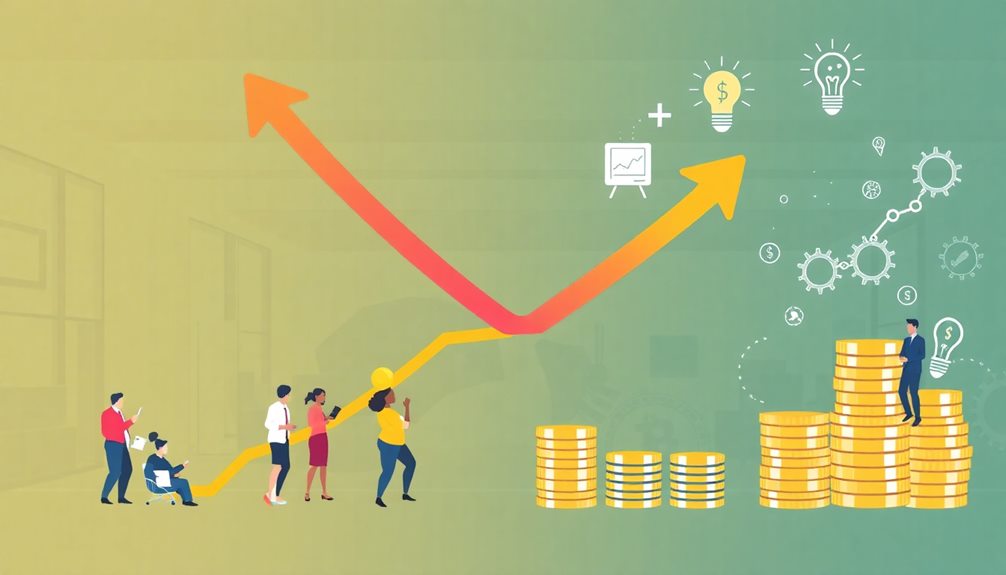Series B funding is essential for your growing company as it helps scale operations and expand market reach after establishing a solid foundation. This round typically features investments averaging around $15.1 million, focusing on businesses with proven revenue and significant growth potential. Investors expect strong metrics, like annual recurring revenue (ARR) growth rates over 100%. You'll need to create an engaging pitch that highlights operational efficiency and your business narrative. Understanding how to present your metrics and what investors look for can make a considerable difference in securing this funding. There's much more you can explore to enhance your strategy.
Key Takeaways
- Series B funding helps growing companies scale operations and enhance product offerings, often focusing on those with proven market viability.
- Investors look for strong metrics, such as annual recurring revenue (ARR) growth rates exceeding 100%, to assess potential.
- The average Series B funding round in Q3 2023 was $15.1 million, indicating significant investor commitment and market confidence.
- Institutional investors, mainly venture capital firms, dominate Series B funding, emphasizing operational stability and effective leadership.
- Companies must prepare compelling pitch decks that clearly present their business narrative, traction, and financial projections to attract funding.
Definition of Series B Funding

Series B funding is a significant step for startups looking to scale their operations and broaden their market presence. This financing round follows Series A and precedes Series C, targeting companies that have already established a solid foundation.
Typically, firms valued at over $10 million participate in Series B, with funding amounts often reaching millions. In this phase, institutional investors, such as venture capital and private equity firms, come into play, aiming to secure around a 15% equity stake in the business.
For startups, this round is essential, as it requires demonstrating significant market traction and revenue growth. Investors want to see that your business has a viable model and the potential for further expansion.
The average size of a Series B round in Q3 2023 was reported at $15.1 million, indicating a shift towards a more competitive funding landscape. With a typical timeframe of 10 to 18 months between Series A and Series B, it's important for you to effectively leverage this opportunity to not only raise capital but also to fortify your business for the next growth phase.
Purpose of Series B Financing

The purpose of Series B financing is to fuel growth for companies that have already proven their market viability and revenue potential. By securing Series B funding, you gain the necessary capital to scale operations and enhance your product offerings.
At this stage, you've likely demonstrated market traction and impressive revenue growth, making you an attractive investment opportunity.
Investors look for companies with established business models and a capable leadership team. They expect to see strong metrics, such as annual recurring revenue (ARR) growth rates exceeding 100% and solid net revenue retention.
With the median funding amount around $15.1 million in Q3 2023, this round represents a significant commitment from investors who believe in your vision.
Series B financing enables you to expand your customer base and enter new markets, stabilizing your revenue generation. This influx of capital helps you solidify your competitive position in the market, paving the way for future funding rounds like Series C.
Ultimately, this stage is essential for propelling your company toward its growth objectives and ensuring long-term success.
Key Characteristics of Series B

When you're exploring Series B funding, you'll notice that investment amounts and valuations markedly differ from earlier rounds.
Investors typically assess the lower risk associated with established companies, leading to higher share prices and substantial equity stakes.
Understanding these dynamics is essential as you navigate the complexities of this funding stage.
Investment Amounts and Valuations
In today's funding landscape, investment amounts and valuations during Series B rounds are vital indicators of a company's growth potential. Typically, these rounds involve larger investment amounts, with the median funding size reported at $15.1 million in Q3 2023, marking a notable decrease from previous years.
Companies seeking Series B financing often showcase valuations exceeding $10 million, reflecting their enhanced market position and higher share prices compared to Series A rounds, where equity offerings usually hover around 15%.
Investors closely assess historical metrics, particularly annual recurring revenue (ARR) growth rates, which should ideally exceed 100%. This scrutiny helps them gauge the scalability and future prospects of the company.
However, securing Series B funding has become increasingly challenging due to heightened competition among startups and various economic factors. As a result, total deals have reached a two-year low as of early 2023.
Understanding these dynamics is essential for entrepreneurs. By aligning their strategies with market expectations regarding investment amounts and valuations, you can considerably improve your chances of success in your Series B round.
Risk Assessment and Stability
Securing Series B funding involves a rigorous risk assessment process, as investors want to guarantee the company has established stability and growth potential. At this stage, the risk associated with investment is lower due to proven revenue growth and a solid product-market fit. Investors typically look for several key indicators to assess your company's readiness for this next phase.
- Demonstrated operational stability with consistent cash flows
- Average annual recurring revenue (ARR) between $4 million and $10 million
- Year-over-year growth rates ideally exceeding 100%
- Key performance metrics like net revenue retention and a burn multiple trending toward 1x or less
These factors not only signal your company's capital efficiency but also reflect its ability to scale effectively.
When preparing for Series B funding, you must showcase how you've maintained operational stability while achieving aggressive growth targets. Investors want assurance that your leadership team can navigate challenges and leverage opportunities, making a strong case for your company's future success.
Investor Participation and Dynamics
Maneuvering the Series B funding landscape requires an understanding of investor participation and dynamics. At this stage, institutional investors, primarily venture capital firms like Andreessen Horowitz and General Catalyst, play a vital role. They not only dominate the funding but also set the tone for funding expectations.
Investors typically look for proven metrics, such as an annual recurring revenue (ARR) between $4 million and $10 million, along with over 100% year-over-year growth. This indicates the company's operational maturity and capital efficiency. Previous investors often increase their stakes, capitalizing on established relationships, while new investors come in at higher valuations, reflecting reduced risk.
Here's a snapshot of the key characteristics of Series B funding:
| Characteristics | Description | Importance |
|---|---|---|
| Average Investment | ~$15.1 million in Q3 2023 | Reflects investor sentiment |
| Investor Types | Primarily venture capital firms | Influences dynamics |
| Expected ARR | $4M – $10M | Indicates company health |
| Year-over-Year Growth | Ideally > 100% | Shows scalability |
| Operational Readiness | Formal leadership team required | Guarantees capital efficiency |
Understanding these dynamics will help you position your company effectively for Series B funding.
Funding Sources for Series B

When you're seeking Series B funding, you'll often turn to venture capital firms and corporate partnerships for significant capital.
Crowdfunding platforms can also provide alternative avenues to secure the funds you need.
Understanding these sources can help you navigate the competitive landscape of funding and support your company's growth.
Venture Capital Firms
Venture capital firms frequently play an essential role in Series B funding rounds, stepping in with larger investments that can reach millions of dollars.
These firms, such as Andreessen Horowitz and Sequoia Capital, focus on companies that have demonstrated product-market fit and significant growth potential.
As you navigate this competitive funding environment, understanding the dynamics of venture capital can be vital for your startup's success. Additionally, awareness of potential pitfalls, such as small mistakes, big impact, can enhance your decision-making as you secure funding.
Here are some key aspects of venture capital firms in Series B funding:
- Larger Investments: Series B funding amounts are on the rise, with some rounds exceeding $100 million.
- Multistage Investors: Many firms are likely to participate in future rounds, like Series C, enhancing your long-term funding strategy.
- Institutional Focus: These investors typically seek startups with proven track records, making your business's past performance essential.
- Market Trends: With the number of Series B deals hitting a two-year low in 2023, standing out becomes increasingly important.
Corporate Partnerships
As your startup seeks Series B funding, exploring corporate partnerships can open up valuable avenues beyond traditional venture capital. These partnerships have become significant sources of Series B financing, offering not just capital but also access to strategic resources and market opportunities.
By aligning with larger corporations, you can enhance your growth potential through collaborative innovations. Many corporate venture arms are keen to invest in startups like yours, as they're drawn to insights into emerging technologies and trends within their industries.
This interest can lead to fruitful relationships where both parties benefit. Engaging in corporate partnerships during your Series B round often brings you mentorship and industry expertise, essential for accelerating your growth and scalability.
Moreover, as corporations look to diversify their investment portfolios, competition for these partnerships is on the rise. This dynamic can work in your favor; by positioning your startup strategically, you can attract the right partners who align with your vision and goals.
Embrace the potential of corporate partnerships, and you might find that they not only provide funding but also invaluable support to navigate the complexities of growth in your industry.
Crowdfunding Platforms
Crowdfunding platforms have revolutionized the way startups secure Series B funding, offering a fresh avenue to tap into a diverse pool of investors.
These platforms democratize access to capital, allowing companies to raise funds from multiple small investors through equity crowdfunding. Unlike traditional venture capital, you can present your business models directly to the public, making it easier to attract investments.
Here are some key benefits of utilizing crowdfunding platforms:
- Broadened Investor Base: Access to a wide range of potential investors.
- Enhanced Brand Visibility: Increased exposure for your startup.
- Community Support: Build a loyal customer base that believes in your vision.
- Complement Traditional Financing: Diversify your funding sources seamlessly.
Importance of Series B Financing

Series B financing plays an essential role in a company's growth journey, often providing the capital needed to scale operations and enhance market presence considerably. At this stage, you're expected to show substantial market traction, typically with an annual recurring revenue (ARR) between $4 million and $10 million.
This funding round allows you to achieve significant milestones before moving on to Series C financing, which is vital for solidifying your competitive position in the market.
With Series B funding typically ranging from $15 million to over $100 million, you gain the resources necessary to expand your customer base and improve your offerings.
Institutional investors, such as venture capital and private equity firms, frequently participate in this round, contributing to a more stable financial foundation for your business. This backing can propel your company towards long-term growth, especially as you aim for year-over-year growth rates exceeding 100%.
Ultimately, Series B financing isn't just about securing funds; it's about positioning yourself strategically for future success and steering through the complexities of evolving funding rounds.
Challenges in Securing Funding

Securing Series B funding can be an intimidating task, especially in 2023, where the landscape has become more competitive.
With total deals dropping to a two-year low, you'll find it essential to navigate this funding stage with care. Investors are now looking for a compelling narrative that highlights both your operational efficiency and proven demand for your product.
To enhance your chances, focus on these key metrics:
- Annual Recurring Revenue (ARR) growth rate
- Net revenue retention
- Burn multiple trending toward 1x or less
- Demonstrated success in your execution capabilities
The average time between Series A and Series B has stretched to about 26 months, so start preparing well in advance.
Investors want to see that you've refined your business strategies and can effectively manage your resources. They favor proactive founders who can showcase their ability to execute plans efficiently.
Overview of Funding Rounds

In the journey of raising capital, startups typically navigate a progression of funding rounds, each designed to fuel growth and development. These rounds begin with seed funding, followed by Series A, and advance to Series B. Eventually, you may reach Series C before considering an initial public offering (IPO).
Each funding round involves investors exchanging cash for equity, allowing you to scale your operations and enhance your market presence. The terms of these investments are based on the series of stock issued by your company. As you progress, the valuation of your company generally increases, reflecting your growth and market potential. For instance, Series B companies are often valued at over $10 million.
Here's a brief overview of the funding rounds:
| Funding Round | Purpose | Typical Valuation |
|---|---|---|
| Seed | Initial capital | Varies, often < $1 million |
| Series A | Expand product reach | $1 million – $10 million |
| Series B | Scale operations | $10 million – $30 million |
| Series C | Market dominance | $30 million+ |
| IPO | Public trading | Varies widely |
Completing these rounds is essential for securing the capital you need.
Valuation Factors in Funding

Understanding the valuation factors during funding rounds can greatly impact your company's financial future. In Series B funding, several key elements come into play that can considerably influence your valuation. Knowing these factors helps you position your company effectively.
- Market Size: A larger market size indicates more growth opportunities.
- Company Potential: Investors look for strong growth trajectories and innovative business models.
- Management Effectiveness: A capable team can drive success and instill investor confidence.
- Net Revenue Retention Rate: A high retention rate showcases customer satisfaction and stable revenue.
During Series B, valuations often exceed $10 million, reflecting the revenue growth achieved since the previous round. Investors assess revenue growth as a vital metric, derived from multiplying market size by market share.
Additionally, a strong net revenue retention rate and year-over-year growth exceeding 100% can positively impact your valuation.
Preparing for the Fundraising Pitch

When preparing for your fundraising pitch, creating a compelling pitch deck is vital, as investors typically spend only a few minutes reviewing it. To capture their attention, make certain your pitch deck is clear, engaging, and visually appealing. A standard structure should include the problem/solution, traction, financial projections, and your overall business narrative.
You need to highlight evidence of operational efficiency and demand for your product. Key metrics, like your annual recurring revenue (ARR) growth rate and net revenue retention, are fundamental in showcasing your company's potential.
Be aware of investor expectations, which can differ by industry and your company's stage of growth. This understanding will help you demonstrate how your business has evolved since the last funding round.
Utilizing pitch deck templates can streamline your preparation process, making sure you include all vital components. Presenting a well-organized pitch deck that addresses investor concerns will greatly enhance your chances of securing Series B funding.
Real-World Examples of Series B

Real-world examples of companies that successfully navigated their Series B funding rounds can provide valuable insights for your own journey. Understanding how to effectively transform your brand through smart marketing strategies can play a vital role in attracting investors.
Take a look at these notable cases:
- Rippling raised $145 million, showcasing strong growth potential and effective fundraising strategies.
- Figma, known for its design collaboration tools, secured $50 million, highlighting its scalability and response to market demand.
- DoorDash raised $127 million, demonstrating its ability to attract notable investors and expand rapidly in a competitive landscape.
In 2023, the median size of Series B funding rounds dipped to about $15.1 million, reflecting the changing dynamics in investor sentiment.
The average time between Series A and Series B has stretched to around 26 months, indicating that companies need to prepare extensively to secure the next round of financing.
Frequently Asked Questions
How Much Revenue Do You Need to Raise a Series B?
To raise a Series B round, you typically need an annual recurring revenue (ARR) between $4 million and $10 million.
This range shows investors that you've achieved a solid product-market fit. Ideally, you should also demonstrate over 100% year-over-year growth to attract interest.
Strong net revenue retention rates are vital, as they indicate your ability to sustain and grow revenue, making your company an appealing investment opportunity for potential backers.
What Is Series B Funding Used For?
You might be wondering where that Series B funding goes, right?
Well, it's all about scaling up. Companies use it to bolster sales and marketing, aiming for a bigger market share.
You'll often see funds directed towards hiring top talent and enhancing tech development, ensuring products meet customer needs.
This round isn't just about growth; it's about laying the groundwork for future expansion, setting the stage for what's next in their journey.
Is It Hard to Get Series B Funding?
Yes, it's hard to get Series B funding right now.
Investors are more selective, demanding strong financial performance along with a compelling narrative about your company's growth.
You'll need to showcase impressive year-over-year growth—ideally over 100%—and demonstrate operational efficiency.
Engaging proactively with potential investors and highlighting your leadership team's capabilities will be essential.
The increased wait time between funding rounds reflects the heightened scrutiny you'll face in this process.
What Happens After Series B Funding?
After securing Series B funding, you'll focus on scaling operations and enhancing your products.
You'll work on expanding your customer base while aiming for impressive growth targets.
Investors will start evaluating your capital efficiency and market competitiveness more rigorously.
It's essential to align your growth strategies with their expectations to guarantee a smoother shift to Series C funding.
Many companies even set their sights on an Initial Public Offering as a long-term goal.
Conclusion
In the ever-evolving landscape of startups, Series B funding acts as the fuel that propels your business to new heights. By understanding its purpose and characteristics, you can strategically position your company for success. With the right preparation and a compelling pitch, you'll be ready to attract the investors who can help turn your vision into reality. Remember, every big journey starts with a single step; let Series B be yours.










